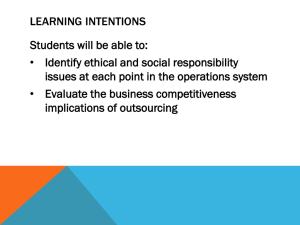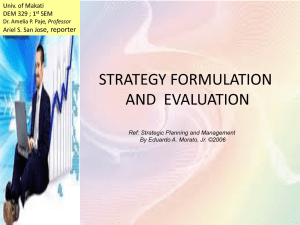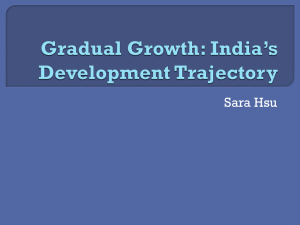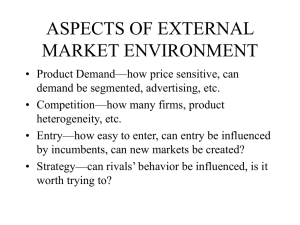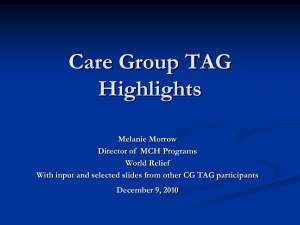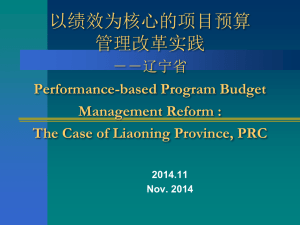click to add title - Support Program for Economic and Enterprise
advertisement
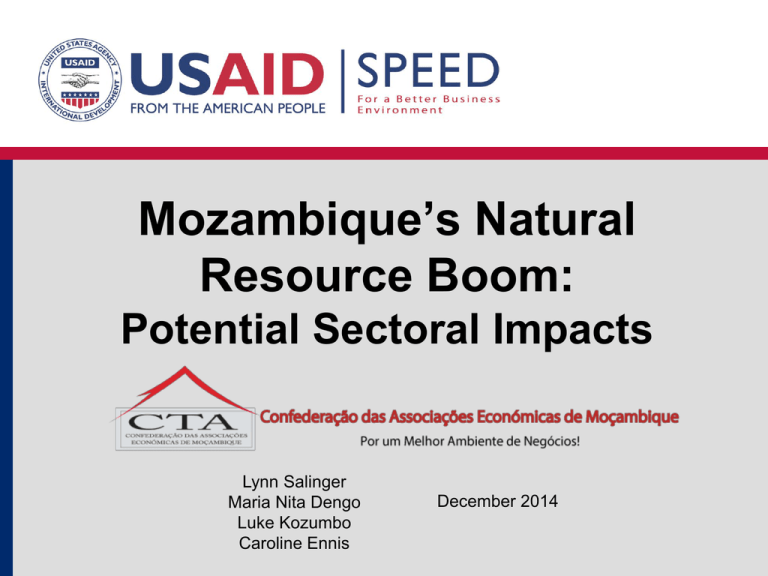
Mozambique’s Natural Resource Boom: Potential Sectoral Impacts Lynn Salinger Maria Nita Dengo Luke Kozumbo Caroline Ennis December 2014 OVERVIEW OF MOZAMBICAN ECONOMY Tradable Sectors Traditional: Agriculture, tourism, manufacturing Non-traditional: Extractives (electricity, heavy sands, coal, natural gas) Non-Tradable Sectors Real estate, construction, transport, logistics, most other services… Factor Markets Land, labor, capital 2 SUMMARY OF NATURAL RESOURCE BOOM EFFECTS 3 Presenters of Four Sectoral Overviews Lynn Salinger Labor markets Luke Kozumbo Tourism Maria Nita Dengo Agriculture Caroline Ennis Manufacturing 4 Potential Impacts on Labor Markets 5 DUTCH DISEASE AND THE LABOR MARKET Theory suggests: • Labor is mobile, geographically and intersectorally • Labor thus “flows” – Out of sectors whose relative prices fall during appreciation (e.g., agriculture, manufacturing, tourism) – Into “booming” sectors, as wages increase in this sector (e.g., extractives) • Increased spending in the economy also leads to increased demand for non tradables – Increased demand for labor, increasing wages, and flow of labor into non tradables (e.g., construction, infrastructure). 6 LABOR MOBILITY: DOES LABOR “FLOW” IN MOZAMBIQUE? • Yes, for the few highly qualified individuals with transferable skills. • To some extent, for some (usually men) who move in search of work in other districts or even outside Mozambique. • No, for the vast majority of the workforce. • No, in terms of inter-sectoral mobility. • Need to better understand labor market dynamics to understand limitations on labor sector mobility and how to improve. 7 THE LABOR MARKET IN MOZAMBIQUE – ASSESSMENT FINDINGS: Skills Barrier to Mobility • Highly segmented by skill level. • Supply constraints are observed not only for highly skilled professionals and managements, but also for skilled technicians and (at times) rural laborers. • For low-skilled labor, technical and “soft skills” are barriers to employment outside of agriculture and informal labor. 8 THE LABOR MARKET IN MOZAMBIQUE – ASSESSMENT FINDINGS: Skills Needed Now • From next year – up to 10,000 construction jobs in Palma. • Interventions addressing skills gaps – but not at sufficient scale or with sufficient urgency, and lacking coordination (INEFP, PIREP, UEM) • Mozal’s Project Labor Agreement – Defined standards and wages for all labor, irrespective of contractor/ subcontractor. – 5700 people trained for construction, 93% pass rate, 72% employed. – Over 1000 permanent operations staff; by year 5, 75% Mozambican. – One interviewee stated that quality of Mozambican labor was “much higher quality than initially foreseen by the company.” • Despite constraints, it is possible to train national workers to an internationally accepted standard and use predominantly national labor even in the extractive sector, as done by Mozal. 9 EXPECTED IMPACT OF DUTCH DISEASE ON LABOR MARKETS IN MOZAMBIQUE Scenario 1: “Business as usual” Scenario 2: Demand-led training for extractive industry only Scenario 3: Comprehensive support to skills, employment generating industries, productivity etc leading to structural transformation of the economy. 10 Potential Impacts on Agriculture 11 SIGNS OF AGRICULTURE SECTOR STRENGTH • Despite expansion of megaprojects (extractives, aluminum, electricity) exports, agricultural exports have maintained share of total merchandise exports (around 18%) over last 7 years • Signs of rising use of improved inputs • Signs of diversification into new value chains (soy-poultry) and rising productivity (cotton, rice) • Evidence of strong foreign investment & partnership interest, in both export & import-substitution crops These emerging gains can be reversed if Mozambican agriculture is not resilient to negative shocks – such as Dutch disease. 12 TO ANALYZE POTENTIAL IMPACTS Five value chains selected, with input from private sector & government: REFERENCE MARKET SCALE OF PRODUCTION Export-oriented Import substitutionoriented Commercial-scale Small Farmerscale Bananas* Cotton* Rice* Rice*, Soybeans, Tomatoes * Value chains of focus identified by Monitor Group in GOM multistakeholder action plan (August 2012) 13 IS MOZAMBICAN AGRICULTURE COMPETITIVE? What have we learned? Current situation (costs, yields and prices) • Bananas, cotton, soybeans, and tomatoes are economically competitive (economic cost-benefit ratios are less than 1.00) But • Rice is not economically competitive (cost-benefit ratio is 1.41) What if the metical strengthened to 20 MT/$ ? • Cotton and soybeans look vulnerable (marginally competitive) • Tomatoes and bananas remain competitive • No need to say, the rice situation becomes worse – competing with cheaper rice from Asian imports becomes a daunting challenge! 14 CAN MOZAMBICAN AGRICULTURE WITHSTAND THE IMPACT OF “DUTCH DISEASE”? What it would take to strengthen competitiveness in case of stronger metical? • 25-45 percent increase in yields restores economic profitability to cotton and soybeans What it would take to compete with rice imports? • Need 9 tons of paddy rice per hectare (more than double current yields) to gain competitiveness even with appreciated metical. Increased productivity and efficiency of agriculture value chains are keys to success! 15 OTHER IMPORTANT FACTORS AFFECTING COMPETITIVENESS…. • Importance of strengthening crop productivities & VC efficiencies now, so that combination of ER effect + Innovation effect will (hopefully) to continue building a competitive agriculture • Target public spending to investments that will offset the threat of the stronger currency through access to markets and infrastructure improvements to enhance the competitiveness of the agricultural sector. • Encourage investments in agro-processing to strengthen the competitiveness of local products through productivity and quality improvements and value-addition, and • Building skills and entrepreneurship – a constraint on competitive commercial agriculture and agribusiness is inadequate management and entrepreneurial skills. 16 OTHER CHALLENGES INCLUDE… • Difficult access to land complicates commercial agriculture, discourages new investments • Logistics/infrastructure constraints (storage, roads, power,…) hamper market access for producers • Trade facilitation constraints (ports, customs, taxation) • Recent increase in agricultural minimum wage (Mozambican plantation workers now paid more than a factory worker in Bangladesh; factory worker minimum wage raised this year in Bangladesh to $68/month vs $100/month for agricultural worker in Mozambique) • Fall in value of rand makes South African goods more competitive 17 Potential Impacts on Tourism 18 OVERVIEW OF TOURISM STUDY • Broad understanding of the competitiveness of two key tourism value chains: business and leisure travel • A quantification of competitiveness constraints on the profitability of the private sector • Perspective on the potential impact of Dutch Disease on the competitiveness of the identified value chains • A tool to identify policy reform priorities that would improve business competitiveness 19 BUSINESS VS. LEISURE: OPERATIONAL COSTS Labor Costs • In full sample, is almost 25% of total revenue due to low productivity • It represents almost 36% for the leisure value chain • It represents 22% in South Africa • It represents 18.4% in India MAIN FINDINGS BASELINE (MZN) BASELINE + 9.6% ER Appreciation (MZN) BASELINE + 50% ER Appreciation (MZN) Revenue 1,687,939,164 1,660,391,997 1,544,464,335 Operating Costs 1,183,304,695 1,188,221,969 1,264,391,660 Taxes 470,525,979 455,730,449 377,414,687 Profit Net of Costs and Taxes 33,760,490 16,091,579 -97,690,013 Outcomes of Scenarios At 10% appreciation: sample sees profitability reduced by 50% At 50% appreciation: sample loses almost 100 million MZN / year 21 MAIN FINDINGS: PRIORITIZING POLICY CONSTRAINTS Improved Profitability from Selected Policy Reforms Select Policy Reforms Profit in Baseline (MZN) 1) Labor Issues Improved 2) Airlines Made Reliable and Price-Competitive 3) Security Costs Decreased by 1% of Firms' Operating Costs 33,760,490 Baseline + Policy Reform Baseline + Policy Reform + 9.6% ER Appreciation Baseline + Policy Reform + 50% ER Appreciation 175.5% 113.8% -225.9% 4.92% -54.97% -388.9% 23.7% -36.1% -369.7% 22 MAIN FINDINGS: IMPROVED PERFORMANCE BY REFORM Increased Profitability Resulting from Selected Interventions in Labor Reform Select Policy Reforms Profit in Baseline (USD) 1) Labor Issues Improved 1.1) Firms Increase Training Expenditures by 1% of Total Operating Costs 1.2) Restrictions Removed on Hiring of Foreign Workers 1.3) Labor Force Reduced by 10% due to Improved Labor Policy Baseline + Policy Reform Baseline + Policy Reform + 9.6% ER Appreciation Baseline + Policy Reform + 50% ER Appreciation 175.5% 113.8% -225.9% 1.6% -57.8% -389.8% 87.0% 23.5% -331.8% 86.9% 28.4% -291.1% 33,760,490 23 TOURISM STUDY CONCLUSIONS • Tourism sector is affected by low productivity of the workforce and costs imposed by weak enabling environment (2% profit after taxes) • In the absence of substantial sector reform, tourism investment will continue to gradually migrate towards areas serving the oil and gas industry • Left unchecked, the onset of Dutch disease would reduce even further the sector’s competitiveness and result in an industry-wide loss of 3.25 million USD per year. • An effective response to improving the sector’s current and future competitiveness includes a combination of productivity improvements and policy reform. 24 Potential Impacts on Manufacturing 25 MANUFACTURING STUDY APPROACH • Literature Review: Key source was surveys of manufacturing companies by MPD-DNEAP. • Semi-structured Interviews were held with range of companies in Maputo-Matola-Beira-Dondo [27]. • Categorisation of firms according to how they might fare under ‘DD conditions’ 26 GOVERNMENT’S STATED OBJECTIVES To industrialize & stimulate economic transformation • PARPA I, PARPA II, PARP • SME Strategy 2007 • EMAN I, EMAN II • Industrial Policy 1997, 2007, forthcoming • SEZs and FTZs • ENDE 2014 • • • • • • Poverty Reduction Job Creation Exports Technology transfer Linkages Diversification 27 However, the manufacturing sector in Mozambique is currently small, not growing, “low tech,” and constrained Manufacturing’s Share of GDP 1993-2013 Key Constraints • • • • • • • 20 15 10 5 0 1993 1998 2003 2008 2013 Bureaucracy and corruption Labor productivity Minimum wages Access to or costs of credit Uncertain environment Irregular electricity supply Customs and ports inefficiencies • Expensive transport costs • Illegal imports 28 Some firms will do better than others in the face of DD Sanguine Neutral / Prepared Disaster! • ‘The market is going to be booming, so we’re not worried.’ • ‘We could hold our own against imports due to strong brand.’ • ‘Most of our orders are short term, so we’re not worried – we’d price in USD.’ • ‘If imports start flooding in, we could import a cheaper line to run alongside our current one.’ • ‘We would stop manufacturing and become an importer’ • ‘It could put our whole production at risk.’ • ‘We’d make a loss.’ • ‘We would have to close down parts of the business.’ • ‘We are not profitable as it is, so we’d just close.’ • ‘We would just close down.’ 29 But those with most direct and indirect job creation potential will likely fare worst….. Product Category Market Examples Outlook Aspirational Consumer Domestic Goods Brand name foods, beverages Favourable Weakly Differentiated Domestic Goods + Strong ValueAdded Services Intermediate goods, e.g. agricultural inputs, construction materials Ambiguous High Quality Consumer Goods Domestic Speciality goods e.g. foods, beverages, home goods. Ambiguous Weakly Differentiated Domestic Basic foods, beverages Difficult Local Value-Added Processing Export Clothing Difficult Standardized Export Intermediate Goods, e.g., threads, textiles Difficult 30 HOW TO PREPARE MANUFACTURING SECTOR FOR DD? • Get the macroeconomics right ! • Address constraints to competitiveness – – – – – Minimum wage policy Focused efforts to improved productivity Investment in infrastructure (electricity, transportation) Cut red tape Promoting technology transfer • Ensure information about key macroeconomic variables are accessible to company decision makers. 31 Summary 32 THREAT OF DISRUPTION FROM BOOM IS REAL • Dutch disease – Currency and exchange rate appreciation – Relative price impacts – Competitiveness impacts • Increased costs of imported inputs • Decreased prices in meticais of imported & exported goods • Decreased economic profitability • Increased vulnerability to commodity price volatility • Weak government institutions increase the odds of economic mismanagement 33 LABOR MARKETS • Immediate impact already felt in skilled worker wages • Given domestic skilled technician shortages, increased demand for foreign skilled workers • Huge need, therefore, to increase supply of skills in Mozambique • Huge need, as well, to increase available labor market information so that youth stay in school longer & get the skills demanded by the market 34 TRADITIONAL TRADABLES SECTORS • Analysis of price and exchange rate changes highlights economic profitability risks • However, programs to address inefficiencies of value chains could also lead to savings that would counterbalance, to some extent, the impacts of Dutch disease • Some possible levers include – – – – – Increased agricultural yields Increased labor skills, labor productivity, labor market info Reduced transport, logistics, trade facilitation costs Increased physical infrastructure penetration Reduced inefficiencies in business enabling environment 35 CONCLUSION • All: Understand the looming economic risks that natural resource booms frequently entail • Youth: Stay in school, seek training in skills that will be in demand in coming years (construction, infrastructure, service industries that will support the boom,…) • Farms & Businesses: Streamline your costs, raise your farms’ & firms’ productivity, invest in workers’ skills, build value-chain linkages to improve your companies’ resilience • CTA: Pressure new government for sound macro-economic management, strategies to minimize commodity market volatility, & initiatives to strengthen transparency and institutional capacity to manage the boom 36 Thank you! Obrigada! 37
